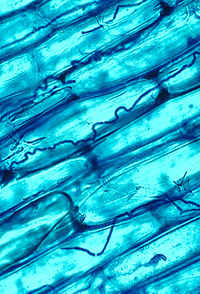
Photo from wikipedia
Abstract Context. Small mammalian herbivores, such as European rabbits (Oryctolagus cuniculus), can have significant unwanted impacts on agriculture and horticulture and can attract birds of prey and avian scavengers to… Click to show full abstract
Abstract Context. Small mammalian herbivores, such as European rabbits (Oryctolagus cuniculus), can have significant unwanted impacts on agriculture and horticulture and can attract birds of prey and avian scavengers to airports, increasing the risk of bird strike. Sustainable wildlife management tools that have high efficacy and animal welfare are needed to mitigate these impacts. Aim. We assessed perennial ryegrass (Lolium perenne) and tall fescue (Festuca arundinacea) cultivars associated with selected Epichloë endophytes, originally developed for bird management at airports, to determine their feeding-deterrent properties towards invasive rabbits. Methods. A pellet feed trial using caged domestic rabbits and a pen trial using wild rabbits were conducted to assess rabbit responses to food pellets with novel endophyte-infected or uninfected grass seed and to plots planted with endophyte-infected or uninfected grasses, respectively. Key results. Caged rabbits ate significantly less food pellets containing endophyte-infected grass straw than pellets containing endophyte-free grass straw. Wild rabbits consumed significantly less herbage from plots planted with endophyte-infected grasses than those of the equivalent endophyte-free grass cultivars. Temporal patterns of rabbit feeding behaviour support the hypothesis that deterrence in rabbits resulted from post-ingestion feedback associated with grass–endophyte secondary metabolites. Conclusions. Although more research is required on the exact mechanism of action in rabbits, our results suggest novel endophyte-infected grass associations may substantially reduce rabbit feeding behaviour and possibly rabbit numbers in areas where these grasses are sown. Implications. Novel grass–endophyte associations have great potential for deterring problem wildlife at airports and other amenity areas.
Journal Title: Wildlife Research
Year Published: 2017
Link to full text (if available)
Share on Social Media: Sign Up to like & get
recommendations!